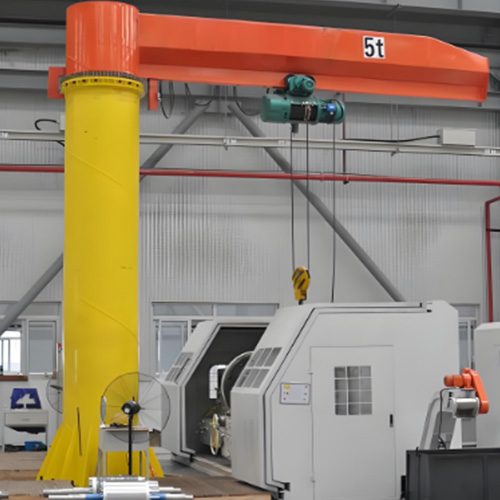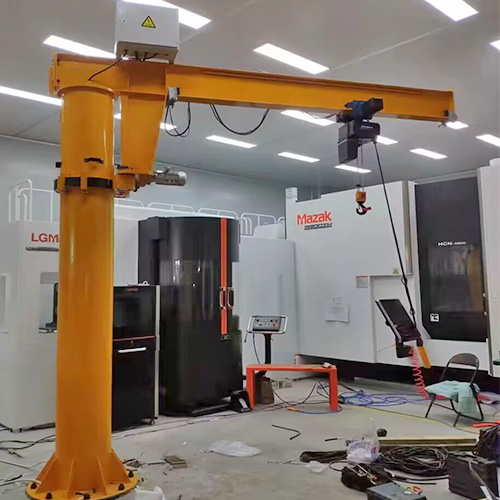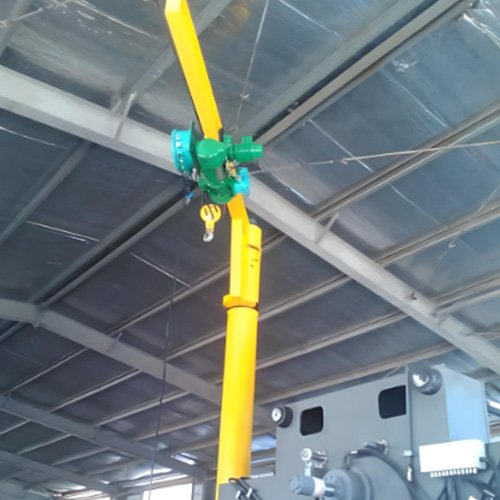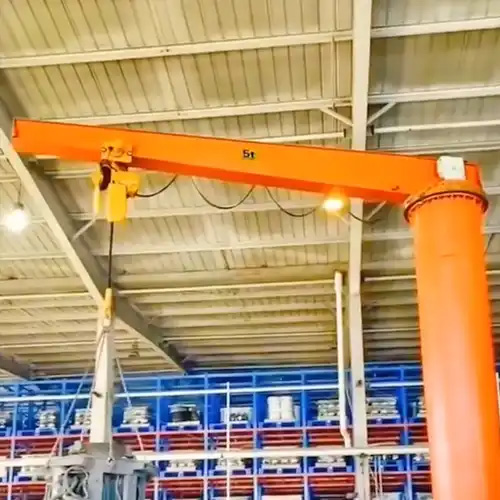5 Ton Jib Crane vs. 5 Ton Gantry Crane/ Overhead Crane /Forklift
Why to select 5 ton jib crane ? Comparing the cost-effectiveness and performance advantages of 5-ton jib cranes against alternative lifting equipment.
Category: Jib Crane Capacity & Tonnages
Your Trusted Jib Crane Manufacturer & Supplier
5 Ton Jib Crane vs. 5 Ton Gantry Crane/ Overhead Crane /Forklift
Why to select 5 ton jib crane ? Comparing the cost-effectiveness and performance advantages of 5-ton jib cranes against alternative lifting equipment.
Optimizing Operations: 5 Ton Jib Cranes vs. Alternatives
In industrial operations, the efficiency of material handling processes stands as a pivotal factor in determining overall productivity. At the heart of these operations lie various lifting solutions, each vying to optimize efficiency while minimizing costs. In this discussion, we delve into the realm of lifting equipment, particularly focusing on the comparison between the stalwart 5-ton jib cranes and alternative lifting solutions. By examining the factors of performance, versatility, and long-term cost-effectiveness, we aim to uncover the inherent value proposition offered by 5-ton jib cranes and the critical importance of selecting the most suitable lifting equipment for optimizing operations in diverse industrial settings.
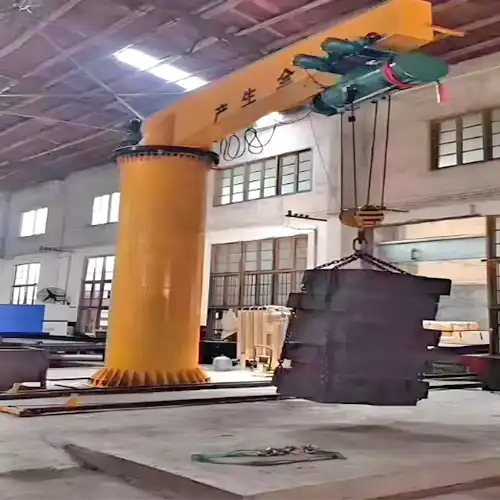
5 Ton Jib Cranes
5-ton jib cranes represent a stalwart in the realm of industrial lifting equipment, renowned for their robust construction and versatile functionality. These cranes are characterized by their ability to handle heavy loads of up to 5 tons with ease, offering a reliable and efficient solution for various material handling tasks.
At their core, 5-ton jib cranes typically consist of a horizontal boom (or jib) that is mounted onto a vertical mast or pillar. This design allows for 360-degree rotation, providing enhanced flexibility and maneuverability in lifting operations. The jib crane's hoist mechanism, which may be manual or powered, further augments its lifting capabilities, allowing for precise control over load positioning and movement.
The applications of 5-ton jib cranes span across a diverse range of industries, where their versatility and robustness make them indispensable assets in material handling processes. In manufacturing facilities, these cranes excel in tasks such as loading and unloading heavy machinery, transporting components between workstations, and facilitating assembly operations. Similarly, in construction sites, 5-ton jib cranes are utilized for lifting steel beams, concrete panels, and other heavy construction materials with precision and efficiency. Additionally, in warehousing and logistics operations, these cranes are employed for loading and unloading cargo, optimizing storage space, and streamlining inventory management processes.
In essence, 5-ton jib cranes embody reliability, versatility, and efficiency, making them an ideal choice for a wide array of material handling applications across diverse industries. Their robust construction, coupled with their ability to handle heavy loads with ease, positions them as indispensable assets in optimizing operations and enhancing productivity in industrial settings.
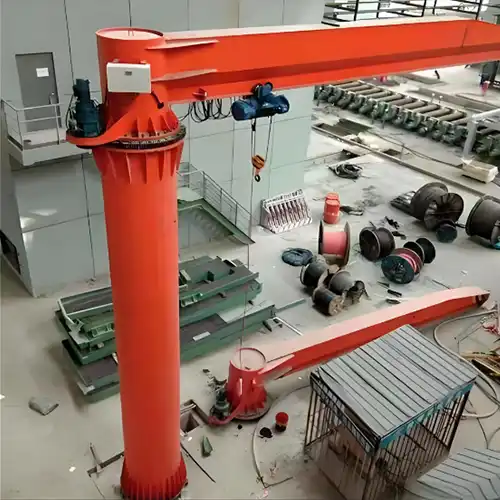
5 ton pillar mounted jib crane

5 ton wall mounted jib cranes
Exploring Alternative Lifting Solutions: 5 Ton Overhead Cranes & Gantry Cranes
While 5-ton jib cranes undoubtedly offer a robust solution for material handling, it's essential to explore alternative lifting equipment to understand the full spectrum of options available in the market. Here, we delve into several alternative lifting solutions, comparing their features, capabilities, and limitations to provide a comprehensive overview.
Overhead Crane 5 Ton :
Overhead cranes, also known as bridge cranes, are a staple in heavy-duty industrial applications. These cranes consist of a horizontal beam (bridge) that spans the length of the facility, with a hoist and trolley mechanism for horizontal and vertical movement. Overhead cranes are renowned for their high lifting capacity and wide coverage area, making them ideal for lifting and transporting heavy loads over long distances. However, their installation and maintenance costs can be significant, and they may require substantial infrastructure modifications to accommodate their operation.
Comparison of 5 Ton Jib Crane vs. Overhead Crane
When deciding between a 5-ton jib crane and a 5-ton overhead crane, several factors must be considered, including crane design, working coverage, typical applications, and objects handled.
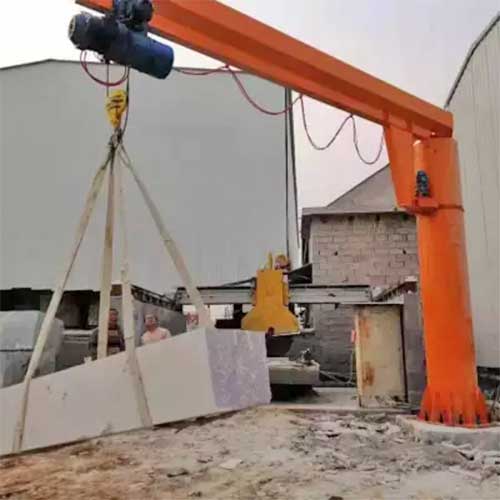
Crane Designs:
5 Ton Jib Crane:
Design: A 5-ton jib crane typically features a vertical mast mounted to a sturdy foundation, with a horizontal boom extending outward. This design allows for a 360-degree rotation, providing coverage within a specific radius.
Working Coverage: Jib cranes have a limited working coverage area determined by the length of the boom and the rotation radius. They are ideal for lifting and maneuvering loads within a confined workspace.
Typical Applications: Common applications include loading/unloading trucks, positioning materials on assembly lines, and transferring heavy loads between workstations.
Objects Handled: Jib cranes are suitable for lifting heavy machinery components, steel beams, construction materials, and equipment.
Pillar Jib Crane:
Typically mounted to a pillar or column, offering stability and support.
Ideal for lifting and maneuvering loads within a limited workspace, such as assembly lines or workstations.
Commonly used in manufacturing, workshops, and warehouses for tasks requiring precision and flexibility.
Suitable for handling heavy machinery components, steel beams, construction materials, and equipment.
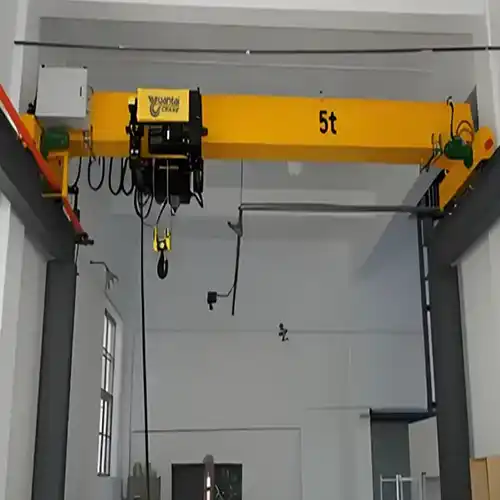
5 Ton Overhead Crane:
Design: A 5-ton overhead crane is typically suspended from the ceiling or overhead structure of a building, with a horizontal bridge that travels along parallel runways. This design provides linear coverage across the length of the runway.
Working Coverage: Overhead cranes offer linear coverage along the length of the runway, allowing for efficient material handling across a larger area compared to jib cranes.
Typical Applications: Common applications include loading/unloading materials in warehouses, manufacturing facilities, and shipping yards, as well as moving heavy machinery in industrial settings.
Objects Handled: Overhead cranes are capable of lifting a wide range of objects, including machinery components, raw materials, finished products, and large structural components.
Overhead Crane:
Suspended from the ceiling or overhead structure, providing linear coverage along parallel runways.
Offers efficient material handling across a larger area, making it suitable for loading/unloading and moving heavy loads in industrial settings.
Widely used in warehouses, manufacturing plants, and shipping yards for versatile material handling operations.
Capable of lifting a wide range of objects, including machinery components, raw materials, finished products, and large structural components.
In summary, the choice between a 5-ton jib crane and a 5-ton overhead crane depends on the specific requirements of the application, such as working coverage, typical objects handled, and space constraints. Jib cranes are ideal for confined workspaces requiring precision and flexibility, while overhead cranes offer linear coverage across a larger area for versatile material handling operations.
compariaon of jib crane 5 ton vs. overhead crane 5 ton. Compare pillar jib crane with overhead crane in terms of crane designs, typical applications, and typical ojbects handled
Overview of 5 Ton Gantry Crane
A 5-ton gantry crane is a versatile lifting solution designed for heavy loads in industrial settings. It features a horizontal bridge supported by two steel legs, offering stability and mobility. With a load capacity of 5 tons, it's ideal for manufacturing, warehousing, construction, shipbuilding, and aerospace industries. Its mobility, stability, and capacity make it a valuable asset for efficient material handling operations.
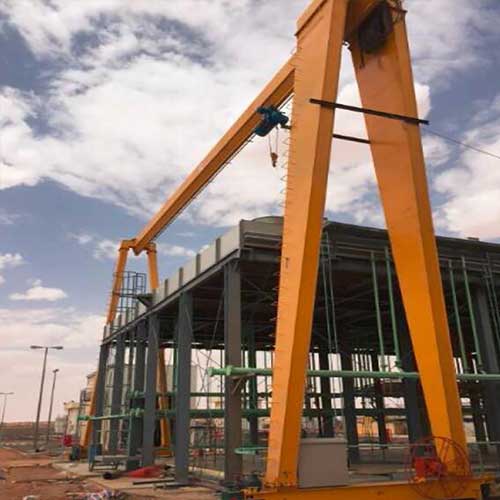
Key Features:
Load Capacity: A 5-ton gantry crane is capable of lifting and moving loads weighing up to 5 tons, making it suitable for medium to heavy-duty lifting tasks.
Bridge Configuration: The horizontal bridge spans the width of the workspace, providing a stable platform for lifting and maneuvering loads. The bridge may be equipped with a hoist or lifting mechanism that travels along the length of the beam to lift and lower loads.
Upright Legs: The two upright steel legs provide support and stability, ensuring safe operation during lifting operations. These legs may be fixed or adjustable in height to accommodate varying load heights and workspace configurations.
Mobility Options: Gantry cranes are designed for mobility, with options for wheeled or rail-mounted configurations. Wheeled gantry cranes are ideal for applications where mobility is essential, allowing for easy relocation within the workspace. Rail-mounted gantry cranes offer greater stability and precision, making them suitable for repetitive lifting tasks along a fixed path.
Typical Applications:
Manufacturing: Gantry cranes are commonly used in manufacturing facilities for lifting and transporting heavy machinery, equipment, and materials.
Warehousing and Logistics: Gantry cranes are utilized in warehouses and distribution centers for loading and unloading shipping containers, pallets, and bulk materials.
Construction: Gantry cranes play a vital role in construction projects for lifting and positioning heavy construction materials, such as steel beams, concrete panels, and precast elements.
Shipbuilding: Gantry cranes are indispensable in shipyards for assembling and launching large ship components and vessels.
Aerospace: Gantry cranes are employed in aerospace manufacturing facilities for handling aircraft components, engines, and fuselage sections.
Advantages:
Versatility: Gantry cranes offer versatility in lifting and moving heavy loads across various applications and industries.
Mobility: The mobility options of gantry cranes allow for flexible positioning and relocation within the workspace, enhancing operational efficiency.
Stability: Gantry cranes provide stable lifting and maneuvering of loads, ensuring safe and precise handling even in challenging environments.
Capacity: With a load capacity of 5 tons, gantry cranes are capable of lifting heavy materials and equipment, making them suitable for medium to heavy-duty lifting tasks.
In summary, a 5-ton gantry crane is a versatile and reliable lifting solution ideal for a wide range of industrial applications. With its robust construction, mobility options, and high load capacity, gantry cranes offer efficient material handling and contribute to enhanced productivity in diverse industrial settings.
Comparison of 5 Ton Jib Crane vs. 5 Ton Gantry Crane
When selecting lifting equipment for industrial applications, businesses often consider various factors such as crane design, typical applications, and objects handled. In this comparison, we'll explore the differences between a 5-ton jib crane and a 5-ton gantry crane, focusing on floor-mounted configurations suitable for both indoor and outdoor use.
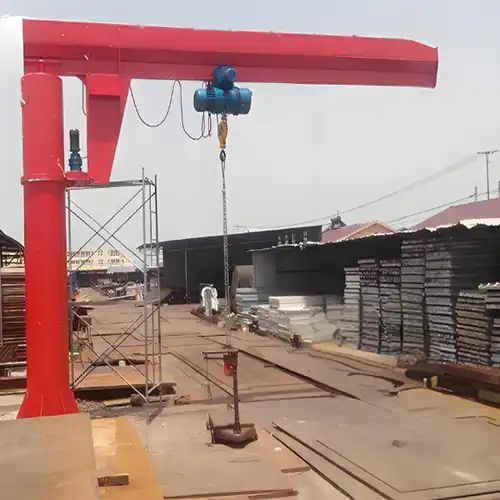
Crane Designs:
5 Ton Jib Crane:
Design: A floor-mounted jib crane typically consists of a vertical mast mounted to a sturdy foundation, with a horizontal boom (jib) extending outward. The jib is capable of rotating 360 degrees, providing coverage within a specific radius.
Versatility: Jib cranes offer versatility in maneuvering loads within a limited workspace, making them suitable for applications where precise positioning is required.
Mobility: Floor-mounted jib cranes are fixed to the ground, offering stability but limited mobility compared to gantry cranes.
Typical Applications:
5 Ton Jib Crane:
Indoor Use: Floor-mounted jib cranes are commonly used indoors in manufacturing facilities, warehouses, and workshops for tasks such as loading/unloading, assembly, and machine maintenance.
Outdoor Use: Outdoor applications of jib cranes include construction sites, shipyards, and loading docks for handling materials and equipment in open-air environments.
Typical Objects Handled:
5 Ton Jib Crane:
Common objects handled by jib cranes include heavy machinery components, steel beams, construction materials, and equipment.
Jib cranes are ideal for tasks such as loading/unloading trucks, positioning materials on assembly lines, and transferring heavy loads between workstations.
Working Coverage:
1. Rotation: Typically, the boom can rotate up to 360 degrees, providing extensive coverage within the crane's reach.
2. Reach: The horizontal boom, or jib, can have a reach extending up to 20 feet or more, depending on the specific model and configuration.
3. Lifting Height: The lifting height can be customized based on the installation requirements but generally ranges from 10 to 20 feet.
4. Area Coverage: The effective working area is a circular zone around the pillar with a radius equal to the length of the jib. For example, a jib crane with a 20-foot boom covers an area of approximately 1,256 square feet (π radius^2).
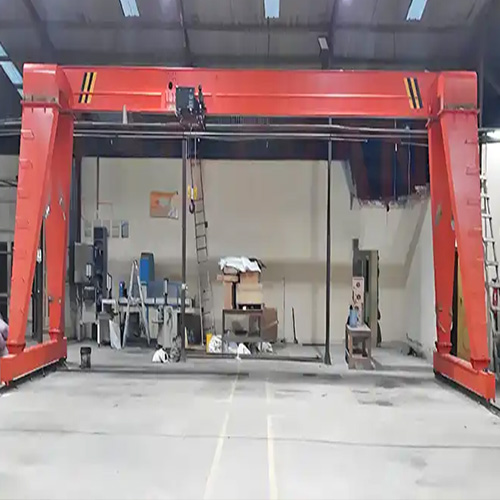
Crane Designs:
5 Ton Gantry Crane:
Design: A gantry crane features a horizontal bridge supported by two upright steel legs, which may be mounted on wheels or rails for mobility. The bridge can travel along the length of the legs, providing coverage across a wider area.
Versatility: Gantry cranes offer versatility in handling heavy loads over a larger workspace, with the ability to move along a fixed path or be relocated within the facility.
Mobility: Gantry cranes can be wheeled or rail-mounted, offering greater mobility and flexibility compared to jib cranes.
Typical Applications:
5 Ton Gantry Crane:
Indoor Use: Gantry cranes are deployed indoors in manufacturing plants, warehouses, and industrial facilities for lifting and transporting heavy machinery, materials, and components.
Outdoor Use: Outdoor applications of gantry cranes include construction sites, shipyards, and storage yards for loading/unloading cargo, assembling structures, and handling oversized objects.
Typical Objects Handled:
5 Ton Gantry Crane:
Gantry cranes are capable of lifting and moving a wide range of objects, including shipping containers, large machinery, structural components, and heavy equipment.
They are commonly used for loading/unloading cargo from trucks and ships, assembling prefabricated structures, and handling oversized or irregularly shaped objects.
Working Coverage:
1. Mobility: A-frame gantry cranes are mounted on wheels or casters, allowing them to be moved to different locations within the work area.
2. Span: The horizontal beam can span distances from 10 to 40 feet or more, providing a wide range of coverage.
3. Lifting Height: The lifting height can vary, with typical ranges from 10 to 20 feet, depending on the gantry height and hoist capabilities.
4. Area Coverage: The effective working area is defined by the crane's span and its mobility. For instance, a gantry crane with a 20-foot span can be moved along a track or across a floor, covering multiple work zones.
In summary, while both 5-ton jib cranes and 5-ton gantry cranes offer effective lifting solutions for indoor and outdoor applications, they differ in terms of design, versatility, and typical applications. Jib cranes are well-suited for precise positioning within a limited workspace, while gantry cranes excel in handling heavy loads over a larger area with greater mobility and flexibility. The choice between the two depends on the specific requirements of the application, such as space constraints, load handling needs, and mobility considerations.
Portable Gantry Cranes
A 5-ton portable gantry crane is a versatile lifting solution designed for easy assembly, disassembly, and transportation to various locations within a facility or worksite. It typically consists of a horizontal bridge supported by two A-frame legs, providing stability and mobility for lifting and moving heavy loads. These cranes offer linear coverage along the length of the gantry rails or runway, making them suitable for a wide range of applications, including workshops, maintenance facilities, and construction sites. With adjustable height and width settings, they can accommodate different types of loads and provide flexibility in material handling tasks.
Comparison of 5 Ton Jib Crane vs. 5 Ton Portable Gantry Crane
When comparing a 5-ton jib crane to a 5-ton portable gantry crane, several factors come into play, including crane design, working coverage, typical applications, and typical loads handling.

Crane Design:
5 Ton Jib Crane:
Features a vertical mast mounted to a sturdy foundation, with a horizontal boom extending outward.
Offers 360-degree rotation for precise positioning of loads within a specific radius.
Suitable for indoor and outdoor use, depending on the mounting location and environmental conditions.
Working Coverage:
5 Ton Jib Crane:
Provides coverage within a limited radius determined by the length of the boom and rotation capabilities.
Ideal for lifting and maneuvering loads within a confined workspace, such as assembly lines or workstations.
Typical Applications:
5 Ton Jib Crane:
Commonly used in manufacturing facilities, warehouses, construction sites, and automotive workshops.
Ideal for tasks such as loading/unloading trucks, positioning materials on assembly lines, and transferring heavy loads between workstations.
Typical Loads Handling:
5 Ton Jib Crane:
Capable of lifting heavy machinery components, steel beams, construction materials, and equipment.
Provides precise control and positioning of loads within its coverage area.
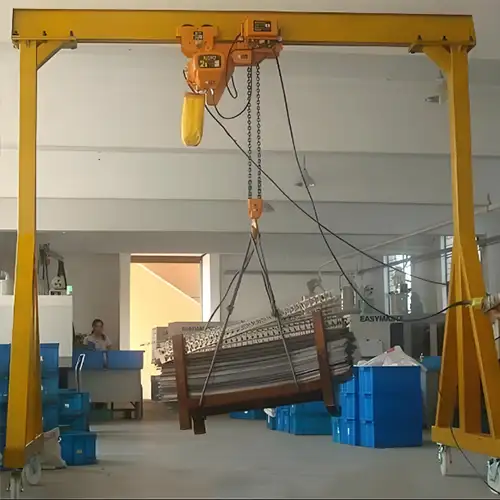
5 Ton Portable Gantry Crane:
Consists of a horizontal bridge supported by two A-frame legs, allowing for mobility and easy setup.
Designed for quick assembly and disassembly without the need for permanent installation.
Can be moved to different locations within a facility or worksite using a forklift or other lifting equipment.
Working Coverage:
5 Ton Portable Gantry Crane:
Offers linear coverage along the length of the gantry rails or runway.
Provides flexibility in lifting and moving loads across a larger area compared to jib cranes.
Suitable for applications requiring mobility and versatility in material handling tasks.
Typical Applications:
5 Ton Portable Gantry Crane:
Widely utilized in workshops, maintenance facilities, and construction sites where temporary lifting solutions are required.
Suitable for tasks such as loading/unloading materials, lifting machinery and equipment, and assembling large components.
Typical Loads Handling:
5 Ton Portable Gantry Crane:
Can handle a wide range of loads, including machinery, equipment, palletized goods, and construction materials.
Offers versatility in load handling with adjustable height and width settings for different types of loads.
In summary, the choice between a 5-ton jib crane and a 5-ton portable gantry crane depends on the specific requirements of the application, such as working coverage, mobility, and installation preferences. Jib cranes offer precise positioning and stability for lifting heavy loads within a confined workspace, while portable gantry cranes provide flexibility and mobility for temporary lifting solutions across various environments.
Comparison of 5 Ton Floor-Mounted Jib Crane vs. Forklifts
When comparing a 5-ton floor-mounted jib crane to forklifts, several factors should be considered, including typical features, working coverage, typical applications, and typical loads handling.
Forklifts:
Forklifts are a ubiquitous sight in warehouses, distribution centers, and manufacturing facilities worldwide. These versatile machines feature a pair of forks attached to the front that can be raised and lowered to lift and transport loads. Forklifts come in various configurations, including electric, gas, and diesel-powered models, each offering unique advantages based on operational requirements. While forklifts excel in maneuverability and versatility, they have limitations in terms of reach and vertical lifting height compared to jib cranes.
Typical Features:
5 Ton Floor-Mounted Jib Crane:
Mounted to the floor with a sturdy foundation, providing stability for lifting and maneuvering heavy loads.
Features a vertical mast and horizontal boom, allowing for 360-degree rotation and precise positioning of loads.
Designed for indoor and outdoor use in various industrial applications.
Can be customized with additional features such as electric hoists, motorized rotation, and safety devices.
Forklifts:
Mobile industrial vehicles equipped with forks for lifting and carrying loads.
Operated by a driver seated in a cab, controlling the movement and lifting of loads.
Available in various configurations, including electric, diesel, and propane-powered models.
Can be equipped with additional attachments such as clamps, rotators, and side-shifters for handling different types of loads.
Working Coverage:
5 Ton Floor-Mounted Jib Crane:
Offers a limited working coverage area determined by the length of the boom and the rotation radius.
Ideal for lifting and maneuvering loads within a confined workspace, such as assembly lines, workstations, or loading docks.
Provides precise positioning of loads within its coverage area, allowing for efficient material handling operations.
Forklifts:
Provides mobility and flexibility in reaching and lifting loads across a wide range of working environments.
Can navigate aisles, tight spaces, and uneven surfaces, offering versatility in material handling tasks.
Suitable for both indoor and outdoor use, making them adaptable to various applications and industries.
Typical Applications:
5 Ton Floor-Mounted Jib Crane:
Commonly used in manufacturing facilities, warehouses, construction sites, and automotive workshops.
Ideal for tasks such as loading/unloading trucks, positioning materials on assembly lines, and transferring heavy loads between workstations.
Forklifts:
Widely utilized in warehouses, distribution centers, manufacturing facilities, and construction sites.
Suitable for tasks such as loading/unloading pallets, stacking goods in storage racks, and transporting materials across the worksite.
Typical Loads Handling:
5 Ton Floor-Mounted Jib Crane:
Capable of lifting and maneuvering heavy machinery components, steel beams, construction materials, and equipment.
Provides precise control and positioning of loads, making it suitable for handling delicate or oversized items.
Forklifts:
Can handle a wide range of loads, including palletized goods, containers, machinery, and construction materials.
Offers versatility in load handling with various attachments and configurations available for different types of loads.
In summary, while both 5-ton floor-mounted jib cranes and forklifts are valuable tools for material handling, they serve different purposes and excel in different environments. Floor-mounted jib cranes offer precise positioning and stability for lifting heavy loads within a confined workspace, while forklifts provide mobility and versatility for handling loads across various indoor and outdoor environments. The choice between the two depends on the specific requirements of the application, such as working coverage, load handling, and operational preferences.
Cost-Effectiveness and Performance
When assessing the suitability of lifting equipment for industrial applications, two crucial factors come into play: cost-effectiveness and performance. In this section, we delve into how 5-ton jib cranes stack up against alternative lifting solutions concerning load capacity, versatility, and operational efficiency.
- Evaluation of Load Capacity: One of the primary considerations when selecting lifting equipment is its load capacity – the maximum weight it can safely lift and maneuver. 5-ton jib cranes are specifically designed to handle heavy loads of up to 5 tons, making them well-suited for a wide range of industrial applications. Compared to alternatives such as forklifts and hydraulic lifts, which may have lower load capacities, 5-ton jib cranes offer superior lifting capabilities, allowing for efficient handling of heavy materials and equipment.
- Versatility: Versatility is another critical aspect to consider when evaluating lifting equipment. 5-ton jib cranes are prized for their flexibility in handling various materials and tasks across different industries. Their 360-degree rotation capability, combined with customizable boom lengths and hoist configurations, enables them to adapt to diverse operational requirements. In contrast, alternative lifting solutions such as forklifts and overhead cranes may have more limited applications or require additional attachments for specialized tasks, reducing their overall versatility compared to jib cranes.
- Operational Efficiency: Operational efficiency plays a pivotal role in optimizing material handling processes and minimizing downtime. 5-ton jib cranes are renowned for their efficiency and ease of use in different environments, thanks to their intuitive controls and ergonomic design. The ability to precisely position loads with minimal effort enhances productivity and reduces the risk of accidents or damage to materials. Additionally, the compact footprint of jib cranes allows for seamless integration into existing workspaces, maximizing floor space utilization and operational efficiency.
In summary, 5-ton jib cranes offer a compelling combination of cost-effectiveness and performance compared to alternative lifting solutions. Their high load capacity, versatility, and operational efficiency make them an ideal choice for a wide range of industrial applications, providing businesses with a reliable and efficient solution for optimizing material handling operations.
Long-Term Cost of Ownership
When investing in lifting equipment for industrial operations, it's essential to consider not just the upfront cost but also the long-term expenses associated with maintenance, downtime, and overall lifecycle. In this section, we delve into the factors influencing the total cost of ownership (TCO) for both 5-ton jib cranes and alternative lifting solutions.
- Maintenance Costs: Regular maintenance is essential to ensure the optimal performance and longevity of lifting equipment. While 5-ton jib cranes typically have lower maintenance requirements compared to complex alternatives like overhead cranes, they still require periodic inspections, lubrication, and component replacements to ensure safe and efficient operation. The simplicity of jib crane design often translates to lower maintenance costs over the equipment's lifespan, making them a cost-effective choice for long-term ownership.
- Downtime: Downtime can significantly impact productivity and profitability in industrial settings. 5-ton jib cranes are known for their reliability and minimal downtime, thanks to their robust construction and simplified operating mechanisms. In contrast, alternative lifting solutions such as overhead cranes may require more frequent maintenance and repairs, leading to increased downtime and operational disruptions. By minimizing downtime, jib cranes contribute to enhanced productivity and a higher return on investment over time.
- Lifecycle Expenses: The lifecycle expenses of lifting equipment encompass all costs associated with ownership, including initial purchase price, maintenance, repairs, and eventual replacement. While 5-ton jib cranes may have a higher upfront cost compared to some alternative solutions, their lower maintenance requirements and longer service life often result in lower overall lifecycle expenses. Additionally, the versatility and adaptability of jib cranes allow them to meet evolving operational needs without the need for costly upgrades or modifications, further enhancing their cost-effectiveness over time.
- Factors Influencing TCO and ROI: Several factors influence the total cost of ownership and return on investment for lifting equipment, including initial purchase price, maintenance costs, downtime, and equipment lifespan. By carefully evaluating these factors and comparing them across different lifting solutions, businesses can make informed decisions to optimize their TCO and maximize ROI. Ultimately, investing in reliable, cost-effective lifting equipment such as 5-ton jib cranes can yield significant long-term benefits in terms of efficiency, productivity, and profitability.
Case Studies and Examples
To further illustrate the performance and cost advantages of 5-ton jib cranes over alternative lifting solutions, let's explore real-world examples from various industries.
Case Study 1: Manufacturing Facility
In a manufacturing facility producing heavy machinery components, the management opted to replace their aging overhead crane system with modern 5-ton jib cranes. The decision was driven by the need for increased flexibility and reduced maintenance costs. By implementing jib cranes, the facility experienced a significant reduction in downtime due to simplified maintenance procedures and improved reliability. The 360-degree rotation capability of the jib cranes allowed for precise positioning of components, resulting in faster assembly times and enhanced productivity. Additionally, the lower upfront cost and reduced lifecycle expenses of jib cranes compared to overhead cranes contributed to substantial long-term savings for the facility.
Case Study 2: Construction Site
On a bustling construction site, the use of forklifts for material handling posed challenges due to limited maneuverability and restricted access to tight spaces. To address these issues, the construction company invested in 5-ton jib cranes strategically placed throughout the site. The jib cranes proved invaluable in lifting and positioning heavy steel beams, concrete panels, and construction materials with precision and efficiency. Their compact footprint and 360-degree rotation capability allowed for seamless integration into the site layout, optimizing space utilization and workflow. As a result, the construction project was completed ahead of schedule, with fewer accidents and delays, demonstrating the superior performance and versatility of jib cranes in construction applications.
Case Study 3: Warehousing Operation
In a busy warehouse handling a diverse range of products, the management sought to improve material handling efficiency while minimizing operational costs. By replacing manual lifting methods with 5-ton jib cranes, the warehouse achieved notable improvements in productivity and safety. The jib cranes enabled workers to lift and transport heavy pallets and cargo with ease, reducing the risk of injury and fatigue. The versatility of the jib cranes allowed for seamless adaptation to changing operational needs, accommodating a wide variety of loads and tasks. With reduced labor requirements and enhanced operational efficiency, the warehouse realized substantial cost savings and improved overall profitability.
These case studies highlight the tangible benefits and cost advantages of 5-ton jib cranes across diverse industrial applications. By leveraging the superior performance, versatility, and cost-effectiveness of jib cranes, businesses can optimize their material handling operations, increase productivity, and achieve significant long-term savings.
Conclusion
In conclusion, the comparison between 5-ton jib cranes and alternative lifting solutions underscores the inherent value proposition offered by jib cranes in terms of performance, versatility, and cost-effectiveness. Throughout this discussion, we have explored the various aspects that contribute to the superiority of 5-ton jib cranes in optimizing material handling operations across diverse industrial settings.
From their robust construction and high load capacity to their flexibility and operational efficiency, 5-ton jib cranes stand out as reliable and efficient lifting solutions capable of meeting the demands of modern industrial applications. The case studies presented further highlight the real-world benefits and cost advantages of jib cranes over alternatives, demonstrating their ability to enhance productivity, reduce downtime, and maximize return on investment.
As businesses continue to prioritize performance and efficiency in their operations, the selection of lifting equipment plays a crucial role in achieving these objectives. By prioritizing the adoption of 5-ton jib cranes, businesses can leverage their superior performance and versatility to optimize material handling processes, increase productivity, and ultimately drive success in today's competitive industrial landscape.
In light of these considerations, we encourage businesses to carefully evaluate their lifting equipment needs and prioritize the adoption of 5-ton jib cranes for their material handling operations. By doing so, they can unlock the full potential of their operations, streamline workflows, and position themselves for long-term success and growth.
Main Projects
Related Products

Supplied three grab bucket crane kits to Indonesia, enhancing garbage handling efficiency with high load capacity and reliable performance.
Free consultation to Confirm Parameters & Specifications and Get
Latest Crane Price & Crane Rate.
- Types of overhead cranes : _______?
- Optional: Overhead travelling crane, goliath gantry crane,Slewing jib crane, Single girder or double girder crane,small portable crane or kbk crane, etc.
- Capacity of overhead crane: _______?
- Optional: 0.25ton, 0.5 ton, 1 ton, 2 ton, 3ton, 5 ton, 10 ton,15ton, 20ton, 25 ton, 30ton,35ton, up to 550ton, etc.
- Crane span & lifting height : _______?
- Crane travelling length : _____?
- Control of overhead crane:_______?
- Optional: pendant/ remote/cabin control
- Voltage supply of overhead crane:_____?
- Eg,: 380V50/60HZ,3Phase or others,etc.
- Application/usage of crane:_______?
- Eg,: Steel mill, ,injection mold, cement,stone, concrete,granite, general manufacturing, etc.
Just leave a message via the contact form and our hoist and crane engineer will contact you with in 24working hours.
Get In Touch




